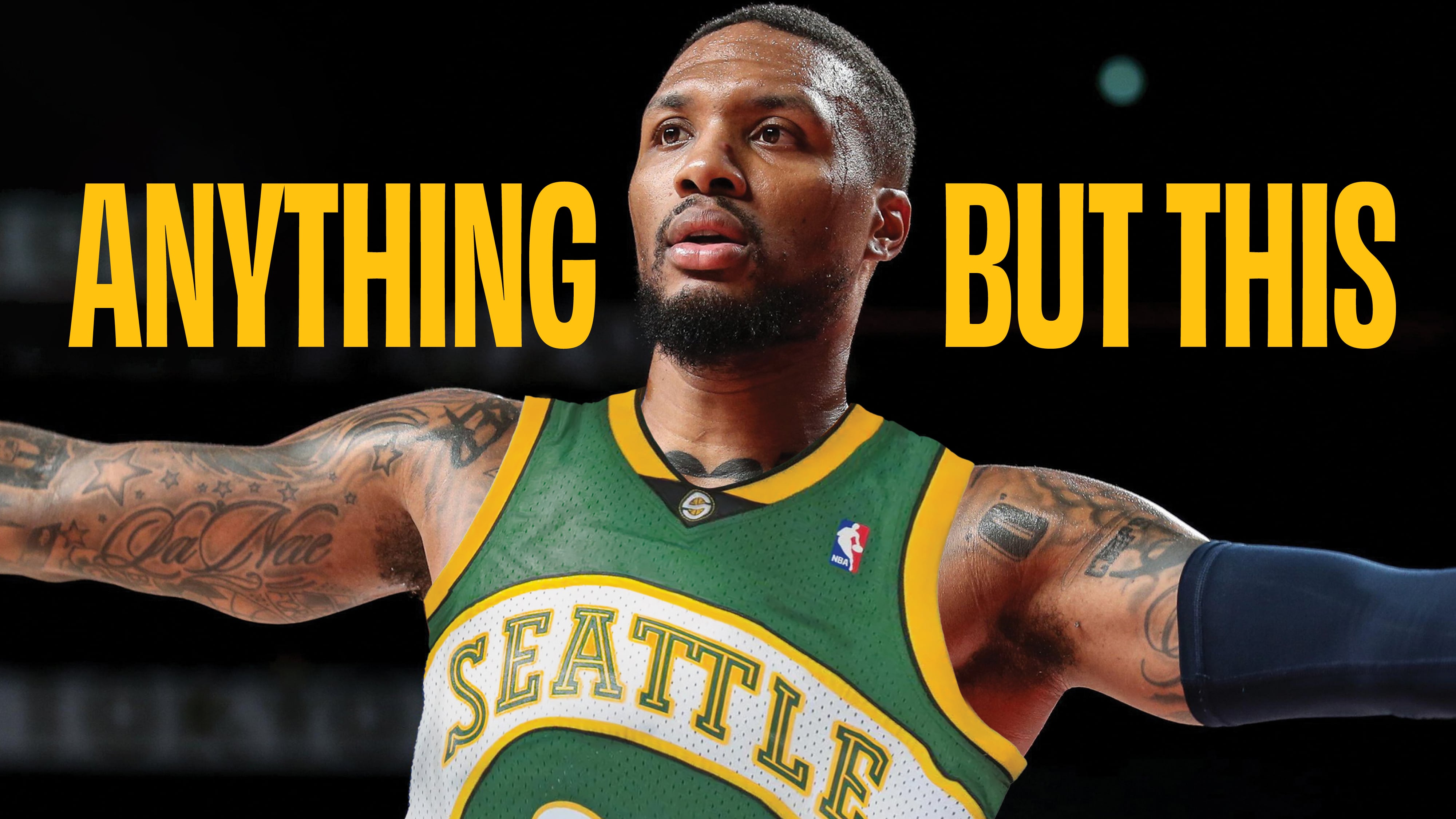We had a spirited debate in our office over whether the image on this week’s cover was going too far.
Damian Lillard came home just weeks ago, and already we’re picturing him in Seattle? Blasphemous. Perverse. The kind of trolling that gets somebody punched.
It’s meant, however, as a warning and a wake-up call.
Supporting the Trail Blazers, as we know, is a path of pain and fear. Over the years, we’ve watched the team lose critical games in grotesque ways and seen its star players’ bones and ligaments ground into dust under Shakespearean circumstances.
But all the things the Blazers have ever done to break your heart would pale in comparison to waking up to read that there were no Portland Trail Blazers.
The unvarnished truth is that the future of the Blazers hangs on the whims of a few hyper-wealthy people with little connection to the city. With the team up for sale—and few prospects emerging for an ownership group with ties to Oregon—the team’s future in Portland has never been less certain, especially given that trendier markets, Seattle and Las Vegas, in particular, are known to covet a franchise.
We invite you to immerse yourself in this fear—to imagine people asking you if you remember when the Nashville Blazers played in Portland—and to experience it as a form of exposure therapy in which you’re shown the things you most dread until you become strong enough to confront them.
“I remember what happened in Seattle, vividly,” says U.S. Sen. Ron Wyden (D-Ore.), referring to the departure of the SuperSonics for Oklahoma City in 2008. “And I will always be a watchdog to make sure that doesn’t happen in Portland.”
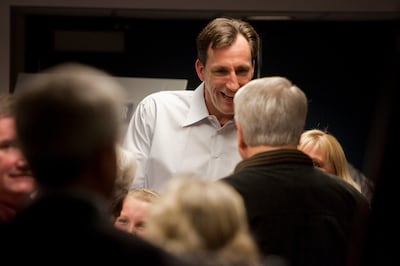
“The story of what happened in Seattle—the similarities are striking,” says Chris Dudley, the former Blazers center who ran for Oregon governor in 2010. “You’re going to most likely have an out-of-town owner buy a team where the arena needs renovation or [replacement], and where the city and state maybe aren’t quite up to speed to handle a negotiation that’s going to come quickly.”
It’s that nightmare that spurred Dudley to join Marshall Glickman, a sports executive and the son of Blazers founder Harry Glickman, to recruit community leaders into an alliance—never previously reported—aimed at keeping the team here.
The advocacy group, Rip City Forever, also counts among its founders former Blazers COO Erin Hubert; Joth Ricci, onetime CEO of Dutch Bros and Adelsheim Vineyards and president of Stumptown Coffee; and Ryan Buchanan of the creative agency Thesis. On July 28, the coalition sent a letter with more than 100 signatories to Gov. Tina Kotek and Mayor Keith Wilson, warning that Portland “will need to compete with other cities who are likely already plotting to woo the next Blazers owner to their city.”
The next day, July 29, Kotek and Wilson wrote to NBA Commissioner Adam Silver. “We heard you loud and clear earlier this summer when you said you wanted to keep the Blazers in Portland under new ownership and made it clear that our arena isn’t up to snuff,” the governor and mayor wrote. “The Blazers are in our DNA, and at the center of what makes this community so special.”
Rip City Forever’s founders fear that without help, local officials are unprepared to deal with the demands that new ownership will present.
Glickman says Portland must learn from Seattle’s example. “They were reactive; they weren’t prepared,” he says. “And by the time they got their act together, it was just too late. Clay [Bennett] got up one morning and said c’est la vie. And he brought in those moving vans in the middle of the night and headed east to Oklahoma City.”
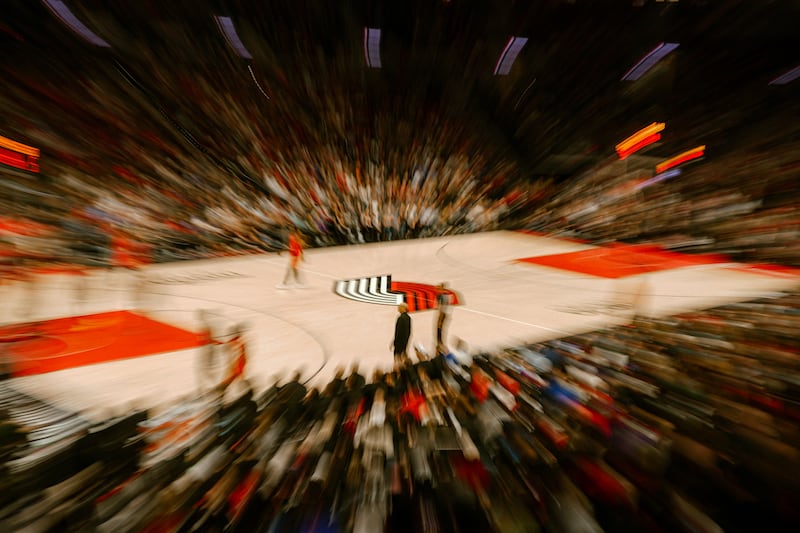
This is the sour undercurrent fouling what has otherwise been a heady summer for the Blazers. The team has jumped from one media cycle-defining event to the next and is now, bizarrely, one of the most compelling franchises in sports.
As recently as January, the team’s basketball prospects were widely viewed as doomed in both the short and long terms.
But then, in short order: The Blazers’ young core started winning games and playing hounding defense. General manager Joe Cronin and head coach Chauncey Billups both received contract extensions and started dealing players: Anfernee Simons and Deandre Ayton out, Jrue Holiday in. They drafted Yang Hansen, a 7-foot-1 phenom who arrived with 300 million Chinese basketball fans in tow.
And then Lillard, the prodigal son with a torn Achilles, announced he was returning to Portland after being released by the Milwaukee Bucks.
“It’s winning time now for the Trail Blazers,” Cronin declared at Lillard’s introductory press conference July 21.

The Blazers now enter what is poised to be one of the most critical seasons in the franchise’s history while facing a litany of questions—the ultimate one being whether the team could leave Portland after being sold.
The team leaving the state, on a purely economic level, would be devastating, as the Rose Quarter alone stands to produce around $6.7 billion in total economic impact over the course of the next 10 years.
“We have to be thinking differently,” says Ricci, the former coffee executive. “Because if we sat back and we watched this happen, I think we all can probably conclude what the end to this story would be.”
It is necessary to view everything the team does within that context. The front office has long been adamant that its decisions are motivated solely by putting the best possible product on the hardwood. But their motives can be pure and the actions still carry ramifications for the team’s sale.
John Hollinger, a former executive for the Memphis Grizzlies who now analyzes the NBA for The New York Times, printed the whispers earlier this month in a report filed from Summer League in Las Vegas, where basketball executives gather to gossip. He said much of that chatter this year focused on the Blazers’ decisions.
“If you’re one of those people who likes to plot out multilayered conspiracies with charts and arrows,” Hollinger wrote, “there’s also plenty of room for that type of thinking.”
We are exactly those people! We invented the Trail Blazers Panic Meter in these pages! Any real Blazers fan keeps the tinfoil hats stored right next to the inflatable thundersticks. We invite you to don those hats now for a tour of the charts and arrows.
Hollinger didn’t respond to our request that he elaborate. Cronin was unavailable for comment. Jody Allen has not given an interview in six years, and it’s been longer than that since her top adviser, Bert Kolde, has spoken to the press.
So what follows is in part conjecture. But it is speculation informed by conversations with longtime government officials, sports executives, and close observers of how the NBA does business. From that, we crafted five assertions that might seem outlandish but have plenty of evidence to support them.
Drafting Yang Hansen likely added at least $1 billion to the Blazers’ sale price.
Let’s start here: When the Paul G. Allen Trust put the Blazers on the market this May, CNBC estimated the team’s value at $3.65 billion. But the trust is selling the Blazers at auction, via the investment bank Allen & Co. Auctions drive prices up—and since it set no terms on the sale (like keeping the team in Portland), the trust has a fiduciary duty to accept the highest bid.
By comparison, the Golden State Warriors are valued at $9.4 billion, and they would probably sell for more than that. The Los Angeles Lakers just sold for well above their valuation, at $10 billion.
The Warriors and Lakers have something in common: Both teams are among the most popular in China. That nation is the league’s biggest market. Low estimates put China’s total number of NBA fans at 300 million—as in, 70 times the number of people in Oregon.
For years, the Houston Rockets were the kings of China by having All-Star center Yao Ming on their roster. (They’re currently valued at $5.7 billion, 22 times their value before drafting Yao.) But Chinese support for the Rockets has dwindled since 2019, when the team’s general manager tweeted in support of the Hong Kong protests and was subsequently blacklisted by every outlet in China, as were the Rockets and, for a time, the NBA itself.
So the moment the Blazers acquired the only player from China currently in the NBA, Yang, they were destined to become the most popular team in China.
Wyden thinks the 300 million figure is low. “We just picked up 1 billion new Blazers fans in China,” Sen. Wyden says. “Our math was a billion.”
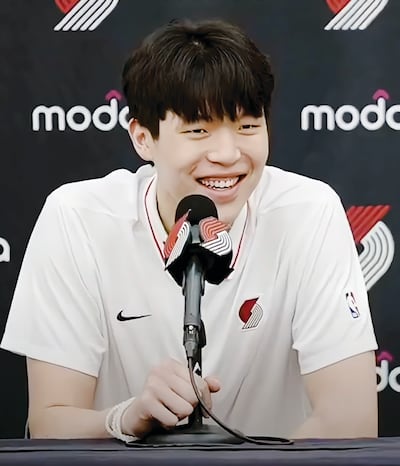
Yang, 20, walked into the NBA draft on June 25 as an almost complete unknown. Over the course of a month and four Summer League games, he has become one of the most famous basketball players in the world.
The implications of drafting him were immediately apparent in Las Vegas, where he was shadowed by dozens of members of the press asking him about his favorite song (New Orleans rapper Rob49’s “WTHelly”) and his thoughts on Damian Lillard. He simply pointed to his wrist while his translator, Chris Liu, himself now a minor celebrity by proxy, laughed and said, “Time to check the watch.”
Yang would appear born to play the role of aw-shucks, gentle-giant international ambassador of basketball, and his exploits in America have generated huge volumes of clicks for the NBA’s and the Trail Blazers’ social media accounts. Playing well and spoon-feeding his teammates layups through backdoor passes has not hurt either.
“Sitting 10 feet from the floor, I watched him diagnose the game offensively unlike any other big I’ve ever seen in that environment,” says Danny Marang, who covers the team for KATU-TV and KFXX-FM.
“As far as his impact off the floor—you had 50 to 60 media members in the house just for Summer League. There will likely be a dozen or so permanently based in Portland this season. You had over 5 million from China tune in to watch a Summer League game!”
It’s difficult to overstate the effect Yang could have on the city and the value of the franchise itself. The Washington Post’s Ben Golliver reported last week that the Blazers had sold 1,024% more merchandise and gained 900,000 followers on Weibo in the five weeks since Yang was acquired.
They will almost certainly play exhibition games in China and unveil Lunar New Year-themed jerseys with their name spelled in Mandarin at some point, things both the Warriors and Rockets have done in the past.
One small indicator of the possibilities: They can sell their jersey sponsorship to the new market. “That’s going to make the value of the jersey patch significantly higher, if they sell it to a Chinese company,” Glickman says.
Nobody local except Phil Knight can afford to buy the franchise.
For years, Oregon’s richest man made no secret of his desire to purchase the Blazers from the Allen estate. Over the past seven years, Jody Allen declined several overtures from Knight, who’d spent a decent amount of time and energy disparaging her in the press. Allen at one point seemed to retaliate by releasing a statement saying that the team’s sale could take “10 to 20 years.”

Knight, in turn, announced he was no longer looking to buy the team the day after Allen put it up for sale in May.
But Knight is the only person with a big enough bag to buy the team outright, as Oregon is otherwise only home to poor billionaires. Knight has a net worth of $36 billion; nobody behind him has more than $4 billion, so any other megawealthy Oregon candidates would have to be part of a consortium.
The team is just as likely to be sold to owners from outside the state, including brand-name oligarchs like Larry Ellison and Jeff Bezos—MacKenzie Scott, Bezos’ ex-wife, was linked to the team in her own right in 2022—as well as the Bhathal family, who own the Portland Thorns and the city’s now-refurbished WNBA franchise, the Fire, but would have to sell off their minority share in the Sacramento Kings. Any number of groups representing private equity and sovereign wealth funds are in play, too.
Private equity firms are not allowed to purchase controlling ownership of a team, however. They are capped at 20% ownership by NBA bylaws. That means if equity is part of a group purchase, the controlling owner (who gets to make decisions like, say, moving the Blazers to San Diego) would need to own at least 21% of the Blazers.
Point being: If the team sells for $4.5 billion, the controlling owner needs $900 million on hand. Not a lot of Oregonians have that kind of dough.
One caveat: If you are willing to expand the definition of local, there is actually one other prospective local buyer, though he hasn’t lived in the state in years.
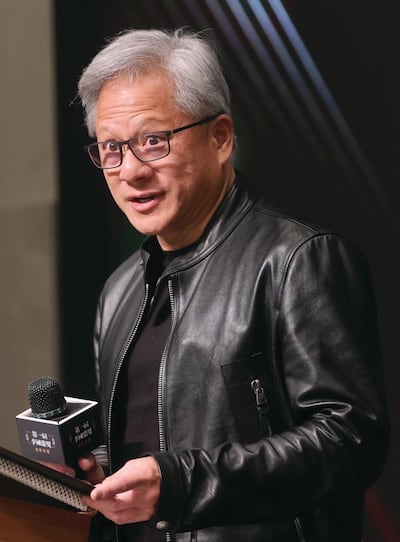
Jensen Huang, CEO of Nvidia and the sixth-richest person in the world, went to Aloha High School. He met his wife in an undergrad class at Oregon State University, to which they donated $50 million three years ago. Nvidia is the world’s leading designer of graphic processing units (GPUs), which have proven as fundamental to the AI Revolution as Intel’s CPUs were to the Silicon Revolution. The company recently surpassed $4 trillion in market cap and is now the most valuable corporation of all time. Huang is the most important person in the world most people don’t know anything about.
WW and The Oregonian have both previously cited Huang as a possible buyer, but there is no real confirmed link besides the idea that he could do it if he wanted to and he has at least enough of a connection to maybe want to. But he has never expressed any interest in basketball.
For what it’s worth, Wyden says he has spoken to several potential buyers but won’t say who they are.
Seattle is no longer assured of getting an expansion team.
For years, the greatest fear of Blazers fans has been that a new owner would decamp for Seattle. And the reassurance offered to those worrywarts was that NBA Commissioner Adam Silver would never allow a repeat of the public relations nightmare created when the SuperSonics left for Oklahoma City in 2008.
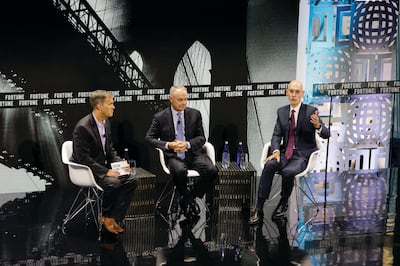
How would Silver prevent that? By making sure Seattle was first in line to get the league’s next expansion team.
In the past few years, an announcement has seemed imminent. In 2022, the Emerald City began hosting preseason NBA games at Climate Pledge Arena, former home of the Sonics that had recently been renovated to the tune of a billion dollars.
Everything is in place for the Sonics’ return, but expansion must be approved by owners of existing teams. And those owners have begun dragging their feet in unanticipated ways. A faction of owners supposedly led by the Knicks’ James Dolan is said to be opposed to splitting revenue with a potential 31st and 32nd team (though the owners would receive huge expansion fees and new teams would boost future media deals).
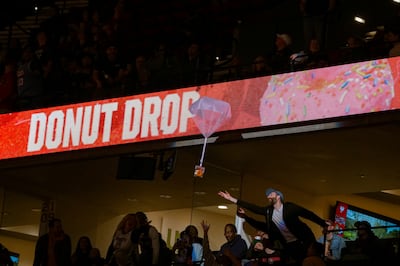
Another group of owners, those in small markets, could also be opposed on different grounds. As longtime reporter Tom Ziller recently wrote: “If the NBA expands to Seattle and another market, existing NBA team owners in non-marquee cities lose their biggest weapon in arguing for local public investment in upgraded arenas.”
In other words: Seattle is most useful to NBA owners as a terrifying bedtime story to tell local townspeople so they’ll pay for a stadium.
There’s some truth to the threat: A city with an uncertain professional basketball future and spotty attendance could see its franchise become the new Sonics before the league gets around to expansion.
To be sure, those terms are far more descriptive of cities like New Orleans or Memphis than Portland, which has never disappointed the league when it comes to putting fans in seats, famously selling out 814 consecutive home games from 1977 to 1995. Even two years ago, when the team went 21-61 (and tickets were priced as low as $2 on the resale market), they were 13th in the league in attendance.
Nonetheless, Dudley says the expansion delay changes the calculus for Rip City Forever: “Originally, when we started, we thought Seattle and Vegas were off the table. And now they’re on the table.”
On July 15, Silver told a press conference that “the league’s preference” is that the Blazers remain in Portland.
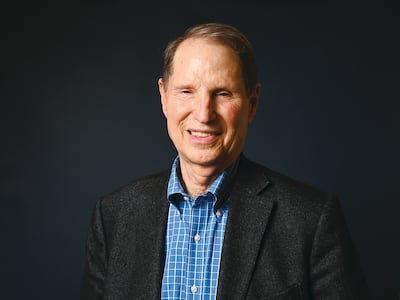
Wyden found that reassuring. “He’s a very close personal friend,” he says of Silver. “I don’t know how he could have taken a stronger position than saying twice in a short news conference that his preference is that the team remain right where Blazers fans want it to be.”
Others did not hear it as a commitment. At the same press event, Silver for the first time voiced a veiled threat from the league to leverage Portland into building a new arena.
The cost of the Blazers staying in Portland is $400 million in public money for a new arena.
The NBA would prefer that every team have as new an arena as possible, and the league is using this moment and the relocation question to leverage that. The way Silver phrased it: “The city of Portland likely needs a new arena, so that will be part of the challenge for any new ownership group coming in.”
The first two things to establish are: (a) do the Blazers actually need a new arena, and (b) will the public have to pay for it?
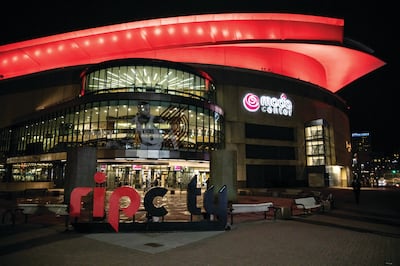
Need would be the wrong word. Moda Center, 30 years old and made almost entirely of concrete and steel, has no structural problems. It needs to be renovated—the process of which has just started—but building a new arena is something that could be kicked down the road about 20 years and done in a more thoughtful way.
But the city of Portland has a weak hand when it sits down to the negotiating table with the Blazers’ new owner.
In 1995, Paul Allen cut a deal with the city. The Microsoft co-founder paid $228 million to build a new arena next to Veterans Memorial Coliseum. The city spent $34 million, and another $10 million came from a bond backed by parking and ticket revenue.
Under the terms of a 30-year deal, the city owned the land under the arena and Allen owned Moda Center itself. The city received the revenues from the Rose Quarter parking garages and a 6% cut from ticket sales. The Blazers kept everything else: ticket sales, concessions, arena naming rights.
That is, until last year. With the 30 years set to expire, the Blazers—operating as Rip City Management LLC—inked a five-year bridge agreement with the city. In other words, they got an extension. As part of that delay, the Blazers sold the arena itself to the city for a dollar.
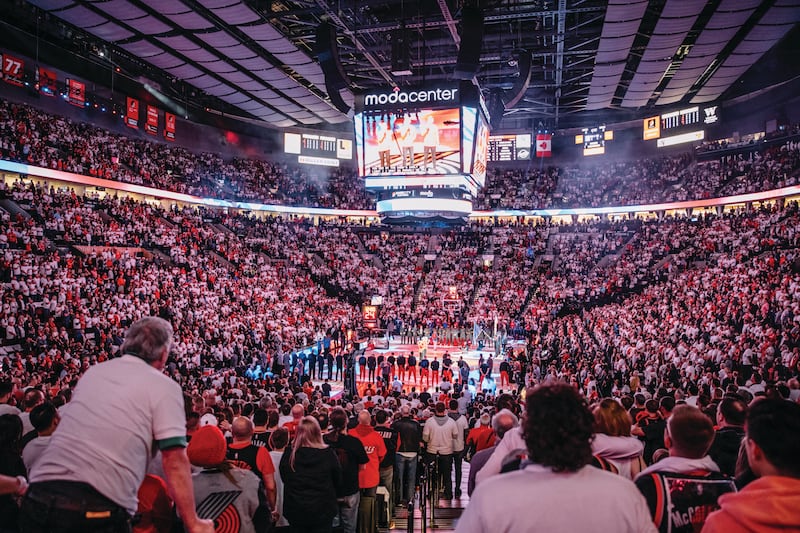
If that sounds like a bargain, think of it more like buying an aging house that needs a new scoreboard on the ceiling. The revenue-sharing model didn’t change—it’s just that the city is now on the hook for upgrading the facility.
More importantly, the team’s new owner has no contractual obligation of any kind to stick around past 2030. The Blazers are being sold as a portable good.
That gives a new owner tremendous leverage in demanding a new arena.
The most recently built NBA arena, the Intuit Dome in Los Angeles, cost $2 billion. The Clippers’ owner, Steve Ballmer, footed the bill. But a better analog to Portland might be San Antonio, where city officials say they’ll contribute up to $500 million to a new, $1.5 billion arena for the Spurs.
So let’s be conservative and say the cost in Portland would be $800 million. The revenues the city gets from the parking garages and 6% of ticket sales won’t come close to supplying $400 million.
Which means the Portland voting public, which is in an anti-tax mood, and the City Council, which abhors billionaires, would need to swallow a $400 million tax measure.
“It’s a massive stumbling block,” Ricci says of the public subsidy.
Kotek and Wilson nodded to that challenge in their letter to Silver. “We fully support renovating the Moda Center to become a point of pride for the Blazers and for our city,” they wrote. “We are prepared to explore the public-private partnerships needed to make it happen.”
Damian Lillard’s salary is a bargain given the goodwill it buys from fans.
Lillard’s return has been euphoric and, along with the progress shown by the rest of the team, has returned the Blazers to above-water vibes for the first time in six years. The salary he’s getting—$42 million over three years—is, by the standards of NBA big-name contracts, negligible.
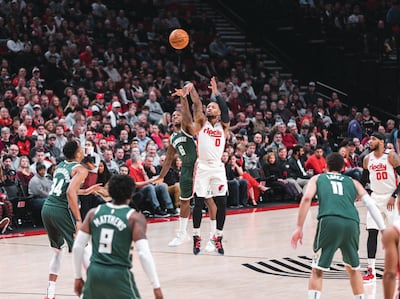
Whether Lillard makes the team more attractive to a buyer is debatable. But his appeal to Oregonians? That’s another story. He’s the most beloved athlete in a generation, and his presence cements an emotional connection you can’t put a dollar figure on.
“It’s a tremendous compliment to the people of Portland and Oregon,” Wyden says. “He wants to come home.”
One of the best days Portland ever experienced was the Blazers winning the title in 1977. Wyden was there for the parade down Broadway, and saw Dr. Jack and Luke and Bill Walton in his full form as warrior-poet. He was there the day Portland conquered the world.
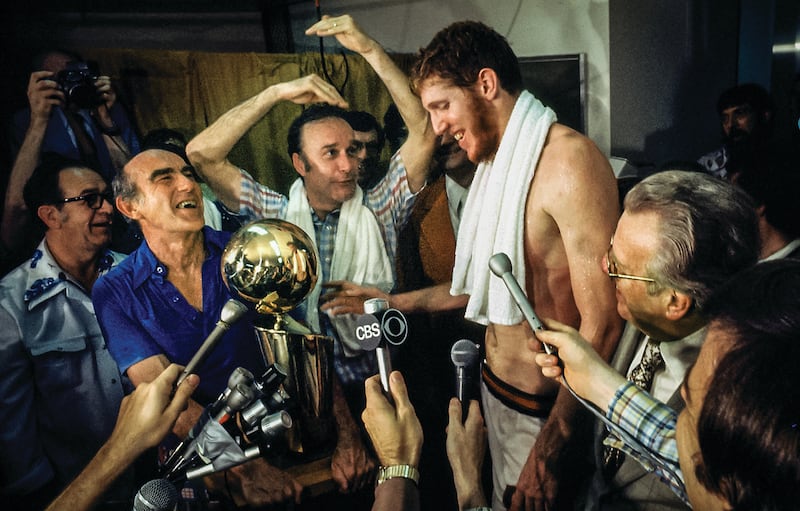
We should all get to see such a day, and we shouldn’t have to live with the idea that something would prevent it from ever arriving.
“This is more than just watching the Blazers get sold,” Ricci says. “This is actually a test to the city and to the state of who it is that we want to be.”
Glickman describes it in more personal terms. His father, Harry, who brought Portland the Blazers, died in 2020 at 96. “When my father passed away,” Marshall Glickman says, “and I was at Beth Israel Cemetery, I said: I cannot fathom the idea of standing over his grave and telling him that the Blazers left.”
The team leaving town is an outcome that cannot be allowed to happen under any circumstance.
The fight to keep the Blazers in Portland has, unfortunately, presented itself as one of the great civic issues of our time. Someday we should be so lucky as to say that we overreacted.
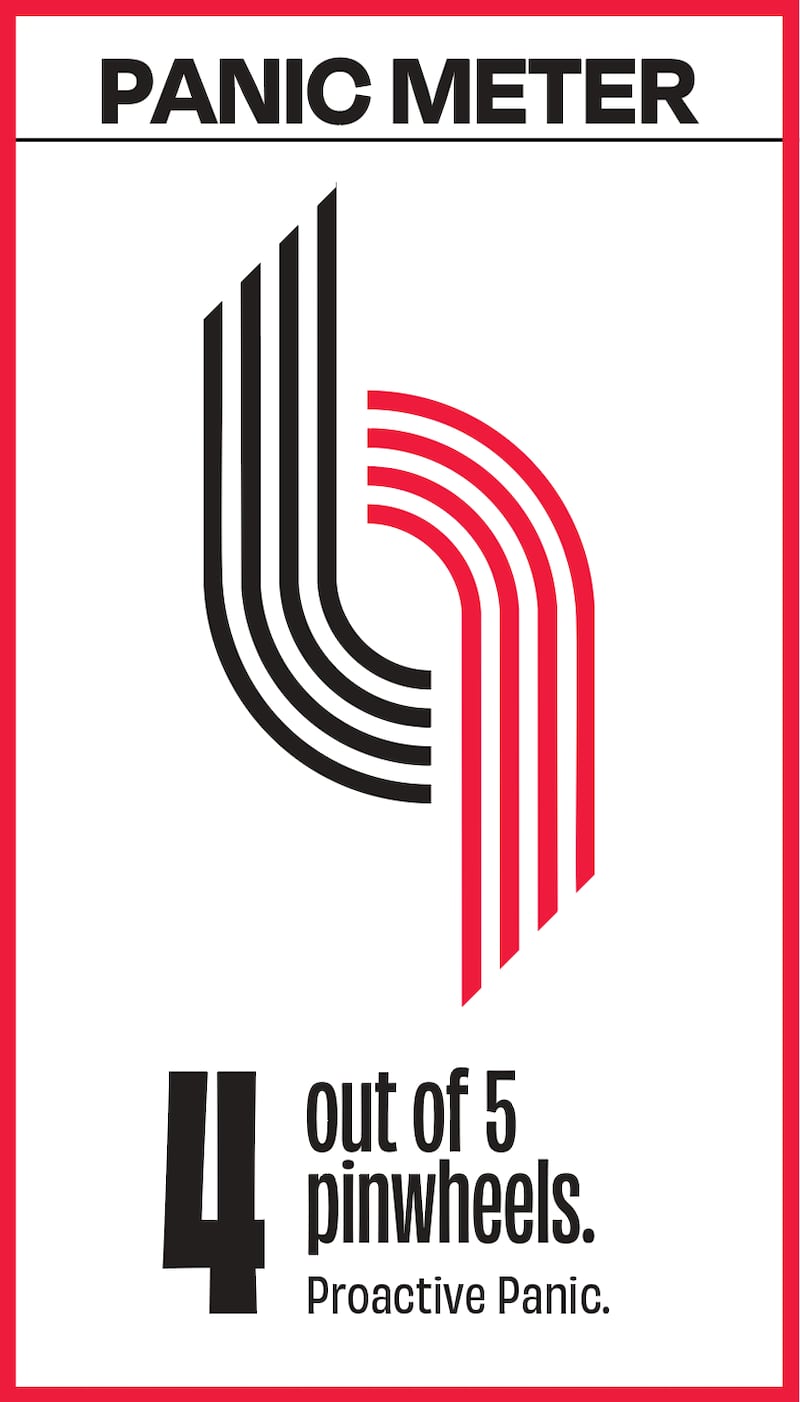
Correction: This story misstated the amount Paul Allen contributed to the construction of Moda Center. It was $228 million, not $46 millon. WW regrets the error.
